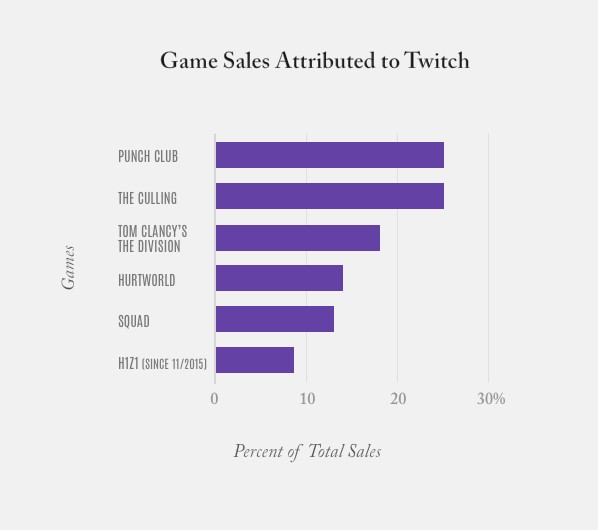Twitch is responsible for 25% of Punch Club and The Culling sales on Steam
Danny Hernandez, a data processing and analysis specialist at Twitch, has published a large study revealing how much streaming can affect the business performance of modern games. A short version of the note is in Russian.

Hernandez’s work is divided into three parts. In the first, he reveals the impact of Twitch on game purchases. The second part is devoted to which streamers are most effective. In conclusion, he talks about the impact on retention.
Money
Danny attributes 25% of Punch Club and The Culling sales to the success of games on Twitch. In his opinion, projects of large companies can also receive a solid part of sales thanks to streaming. In particular, Twitch is responsible for 18% of sales of Tom Clancy’s The Division from Ubisoft (we are talking about Steam sales).

Hernandez tells how he calculated these percentages using the Punch Club example. In 6 weeks, 1.2 million people got acquainted with Punch Club via Twitch. 2.8% of viewers whose Twitch accounts were linked to their Steam accounts left to buy the game. If we assume that the global Twitch audience behaved like viewers with Steam-linked accounts (0.53% of Twitch views), then the service can just claim to be responsible for a quarter of the game’s revenue from Steam.
Streamers
The bigger the reach, the bigger the sales?
This is definitely not fair to streamers. The channels of “middle-level” video bloggers are 13 times more efficient at converting views into sales than top stars. Small channels can be more effective than top ones in terms of conversion almost 1000 times better.
Does this mean that top bloggers should be ignored? Danny thinks not, because the leading streamers attract attention to the project of smaller streamers.
A striking example is the case of the Hurtworld game. After one of the top Twitch streamers Lirik played the game, bloggers with medium-sized audiences paid attention to the project. As a result, of the 10% of sales that Twitch generated, 52% came from medium-sized channels.
By the way, one viewing is unlikely to be enough for sales. In the case of Hurtworld, 83% of Twitch sales came from bloggers who made streams on at least three different days. 80% of sales came from those who had been on the alert for at least 10 hours.
However, we are not sure whether we have correctly understood how Danny estimates the size of the streamers’ audience. He introduces the concept of concurrents, which we tend to interpret as the number of viewers of a broadcast in real time.
If our interpretation is fair, then according to Hernandez, those bloggers whose average number of live viewers ranges from 33 to 3333 fall within the framework of “middle-level” streamers.

Retention
Those users who watch the game on Twitch are held better. As part of Dota 2, streaming increases the retention of the second week by 5%: those who played Dota in the first week are 5% more likely to reappear in the project in the second week if they also watched streams of this game in the first week.

But here’s the moment. The cause could be confused with the effect. It means that Dota could contribute to views on Twitch, and not vice versa. To eliminate this situation, Danny compared the retention of those players who watched and did not watch Twitch. So he got a 3% retention increase.
There was also a direct relationship between retention in the second week, depending on how many days the user played in the first week. The push from Twitch is insignificant if the player played for 5 or more days in the first week, but it seems noticeable with the initial less involvement in the project.

The graph below shows that Twitch’s influence on Dota is minimal and plays a much larger role in less popular products.

Source: Twitch